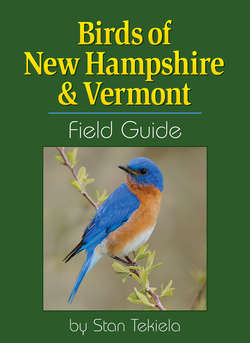Читать книгу Birds of New Hampshire & Vermont Field Guide - Stan Tekiela - Страница 33
На сайте Литреса книга снята с продажи.
Оглавлениеfemale
male
Rose-breasted Grosbeak
Pheucticus ludovicianus
SUMMER
| Size: | 7-8" (18-20 cm) |
| Male: | A plump black-and-white bird with a large, triangular rose patch in the center of chest. Wing linings are rosy red. Large ivory bill. |
| Female: | heavily streaked brown and white bird, large white eyebrows, orange yellow wing linings |
| Juvenile: | similar to female |
| Nest: | cup; female and male construct; 1-2 broods per year |
| Eggs: | 3-5; blue green with brown markings |
| Incubation: | 13-14 days; female and male incubate |
| Fledging: | 9-12 days; female and male feed young |
| Migration: | complete, to Mexico, Central America and South America |
| Food: | insects, seeds, fruit; comes to seed feeders |
| Compare: | Male is very distinctive with no look-alikes. |
Stan’s Notes: Seen in small groups throughout New Hampshire and Vermont during spring and migration. Often prefers a mature deciduous forest for nesting. Both sexes sing, but the male sings much louder and clearer. Sings a rich, robin-like song. Common name “Grosbeak” refers to its large bill, used to crush seeds. Rose breast patch varies in size and shape in each male. Males have white wing patches that flash in flight. Males arrive at their destinations first, joined by the females several days later. Several will come to seed feeders at the same time during spring. When the females arrive, males become territorial and reduce their visits to feeders. Young grosbeaks visit feeders with the adults after fledging.
